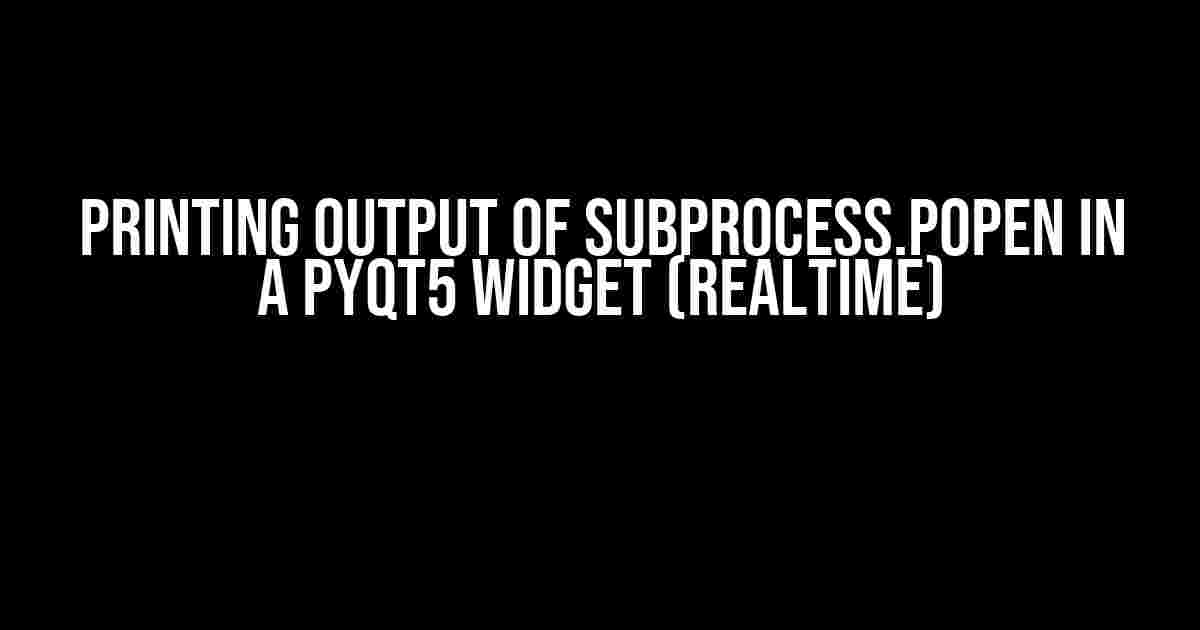When it comes to building GUI applications with PyQt5, one common challenge is displaying the output of a subprocess in real-time. This can be particularly useful when running external commands or scripts that produce output, and you want to display this output to the user in your PyQt5 application. In this article, we’ll explore how to printing output of subprocess.Popen in a PyQt5 widget in real-time.
Understanding Subprocess and PyQt5
Before diving into the solution, let’s quickly review the basics of subprocess and PyQt5.
Subprocess is a Python module that allows you to spawn new processes, connect to their input/output pipes, and obtain their return codes. It’s commonly used to run external commands or scripts from within a Python script.
PyQt5, on the other hand, is a set of Python bindings for Nokia’s Qt application framework. It provides a comprehensive set of libraries and tools for building GUI applications in Python.
The Challenge: Printing Output of Subprocess.Popen in Realtime
When running a subprocess using subprocess.Popen, the output is not automatically displayed in your PyQt5 application. Instead, it’s stored in the subprocess’s stdout pipe, which can be accessed using the stdout attribute of the Popen object.
To display this output in real-time, we need to read from the stdout pipe and update our PyQt5 widget accordingly.
The Solution: Using QThread and QTextBrowser
One approach to solving this challenge is to use a QThread to run the subprocess and read from its stdout pipe, and a QTextBrowser to display the output in real-time. Here’s an example code snippet:
import sys
import threading
import subprocess
from PyQt5.QtWidgets import QApplication, QTextBrowser, QWidget, QVBoxLayout
from PyQt5.QtCore import QThread, pyqtSignal
class Worker(QThread):
outputSignal = pyqtSignal(str)
def __init__(self, command):
QThread.__init__(self)
self.command = command
def run(self):
process = subprocess.Popen(self.command, shell=True, stdout=subprocess.PIPE, stderr=subprocess.STDOUT)
for line in iter(process.stdout.readline, b''):
self.outputSignal.emit(str(line, 'utf-8'))
class MainWindow(QWidget):
def __init__(self):
QWidget.__init__(self)
self.layout = QVBoxLayout()
self.textBrowser = QTextBrowser()
self.layout.addWidget(self.textBrowser)
self.setLayout(self.layout)
self.worker = Worker(['python', '-c', 'import time; for i in range(10): print(i); time.sleep(1)'])
self.worker.outputSignal.connect(self.appendText)
self.worker.start()
def appendText(self, text):
self.textBrowser.append(text)
if __name__ == '__main__':
app = QApplication(sys.argv)
window = MainWindow()
window.show()
sys.exit(app.exec_())
In this example, we create a QThread subclass called Worker that runs the subprocess using subprocess.Popen. We then use a signal-slot mechanism to emit the output line by line, which is connected to a slot function appendText in our MainWindow class. This function appends the output to a QTextBrowser widget, displaying the output in real-time.
Advantages and Limitations
This approach has several advantages, including:
- Real-time output display
- Non-blocking GUI
- Easy to implement
However, it also has some limitations, such as:
- Limited control over the subprocess
- Potential issues with Unicode characters
Overall, this approach provides a simple and effective way to printing output of subprocess.Popen in a PyQt5 widget in real-time.
Conclusion
In this article, we’ve explored how to printing output of subprocess.Popen in a PyQt5 widget in real-time using QThread and QTextBrowser. This approach provides a convenient way to display the output of external commands or scripts in your PyQt5 application, and is suitable for a wide range of use cases.
We hope you find this article informative and helpful in your own PyQt5 development projects.
Frequently Asked Question
Got stuck while trying to print the output of subprocess.Popen in a PyQt5 widget in real-time? Worry not, we’ve got you covered!
Q: How can I print the output of subprocess.Popen in a PyQt5 widget?
A: You can use the `communicate()` method to get the output of the subprocess and then print it to a PyQt5 widget using a `QTextEdit` or `QPlainTextEdit`. You can also use `QTimer` to read the output in real-time.
Q: How do I update the PyQt5 widget in real-time while the subprocess is running?
A: You can use `QTimer` to periodically read the output of the subprocess and update the PyQt5 widget. You can also use `QThreads` to run the subprocess in the background and emit signals to update the widget.
Q: What is the best way to handle large output from subprocess.Popen in PyQt5?
A: You can use a `QBuffer` to store the output of the subprocess and then read it in chunks to avoid memory issues. You can also use `QTemporaryFile` to store the output temporarily and then read it into the PyQt5 widget.
Q: How can I handle errors and exceptions while printing the output of subprocess.Popen in a PyQt5 widget?
A: You can use `try-except` blocks to catch exceptions and errors while running the subprocess. You can also use `QErrorMessage` to display error messages to the user. Additionally, you can use `QTimer` to retry the operation if it fails.
Q: Can I use threading to improve the responsiveness of my PyQt5 application while printing the output of subprocess.Popen?
A: Yes, you can use threading to improve the responsiveness of your PyQt5 application. You can create a separate thread to run the subprocess and update the widget using signals and slots. This way, your GUI will remain responsive while the subprocess is running.




